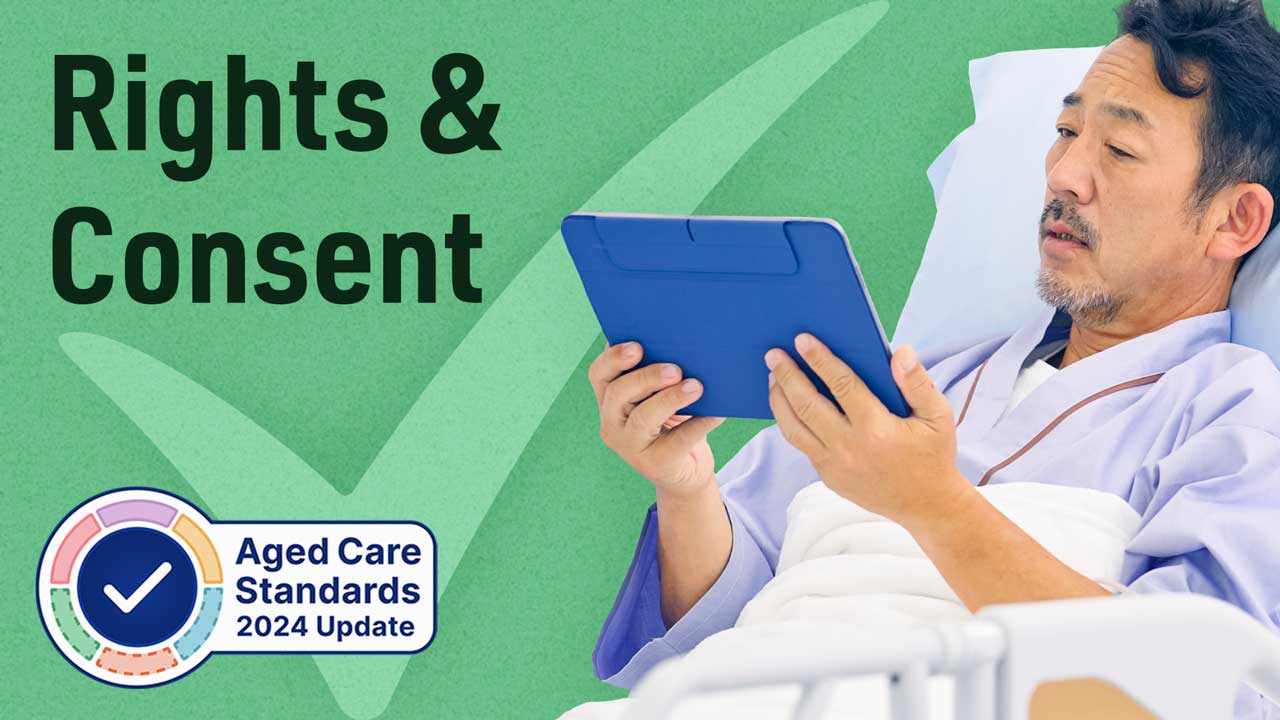All clients have the right to receive safe, appropriate care that respects their privacy and autonomy.
An essential component of this is adequately informing clients about the care they are receiving and ensuring they provide informed consent for any treatments or procedures.
What Are a Client’s Healthcare Rights?
The Australian Charter of Healthcare Rights outlines the rights of all clients receiving care and applies to every facility that provides healthcare.
| Access |
|
| Safety |
|
| Respect |
|
| Partnership |
|
| Information |
|
| Privacy |
|
| Give Feedback |
|
(ACSQHC 2020)
What is Informed Consent?
In the Australian Charter of Healthcare Rights, informed consent falls under the heading of ‘information’.
Informed consent is the ability for a client to voluntarily agree or disagree to different aspects of their care, based on information about the potential benefits, risks and alternative options (RACGP 2019).
It’s a key component of consumer-directed care based on the client’s right to autonomy (Queensland Health 2017).
Clients have a legal right to be informed about their condition and any proposed healthcare interventions. Using the information given to them, clients may accept or decline these interventions. They must also be free to change their decision if they wish to do so (Better Health Channel 2014; Queensland Health 2017).
Clients can only provide informed consent if they are given sufficient, clear information and fully understand the nature of what is being proposed. Without being properly informed, clients are unable to give valid consent. The provider may then be held legally liable for breaching the client’s bodily autonomy (Better Health Channel 2014; ALRC 2014).

When is Informed Consent Required?
Any form of healthcare requires some type of consent. Healthcare includes:
- Examinations
- Investigations
- Procedures
- Interventions
- Treatments
- Screenings
- Medication administration
- Transfers between healthcare facilities.
(Queensland Health 2017)
The consent required is proportionate to the risks of the specific care. In other words, simple procedures and examinations that are relatively low-risk do not require the level of consent that invasive or high-risk procedures do (Queensland Health 2017).
Types of Consent in Healthcare
- Implied consent is expressed through actions rather than direct agreement from the client. For example, when providing a blood sample, a client may extend their arm so that the needle can be inserted. Generally, implied consent is acceptable for low-risk procedures.
- Verbal consent is an explicit verbal statement of agreement from the client. Verbal consent can be given for low-risk procedures such as intravenous cannula insertion or dental treatment.
- Written consent is an explicit agreement through writing or the signing of a document. Signatures should generally be accompanied by supporting documentation that outlines the communication process.
(Queensland Health 2017)
Written consent is generally only required if:
- The proposed intervention poses a significant risk to the client
- The proposed intervention is controversial
- The client’s capacity to consent may be put into question.
(Queensland Health 2017)

Informed Consent in Aged Care
Standard 1: The Person - Outcome 1.3: Choice, independence and quality of life of the strengthened Aged Care Quality Standards looks extensively at the importance of facilitating informed decision-making and gaining informed consent from older people. Under this outcome:
- Action 1.3.1 states that older people should be given up-to-date, accurate and timely information presented in a way they can understand, ensuring they have all the information they need to make informed decisions.
- Action 1.3.2 requires older people to give informed consent where required for treatments, procedures and interventions.
- Action 1.3.3 requires that older people who need support with decision-making are provided access to this support. This might include the support of family and carers, or the use of a substitute decision-maker only if all other options are exhausted.
(ACQSC 2024)
The strengthened Quality Standards also list specific situations where aged care workers must seek and document informed consent from an older person. These include:
- Changes to agreed care and service fees
- The collection, use, storage or disclosure of an older person’s health information
- The disclosure of assessment and planning outcomes to other parties involved in an older person’s care
- When the use of a restrictive practice is being considered.
(ACQSC 2024)
Principles of Informed Consent
All of the following conditions must be met in order for a client to give valid informed consent:
- The client has the capacity to give informed consent at the time of the decision and is not affected by drugs, alcohol or medication.
- The client gives consent voluntarily, without coercion, manipulation or undue pressure.
- The discussion between the client and health professional is transparent, well-balanced and two-sided.
- The client fully understands the information provided.
- The client has been sufficiently informed about:
- Their diagnosis and its likely outcome
- What the proposed intervention involves
- The anticipated benefits of the proposed intervention
- The common side effects of the proposed intervention
- The alternative options to the proposed intervention and their likelihood of success
- The risks and complications associated with:
- The proposed intervention
- The alternative options
- Refusing the proposed intervention.
- Any expected long-term physical, emotional, mental, social, sexual or other outcomes
- The anticipated implications of recovery
- Specific details of the proposed intervention, including who will perform it and where it will occur.
- The client has been given enough time to properly consider, clarify and contextualise the information provided to them.
- The information given to the client and the client’s consent match the intervention that is actually provided.
- The proposed intervention is lawful.
(Queensland Health 2017; Better Health Channel 2014)
Who Can Give Informed Consent?
All adults (over the age of 18), regardless of age, are presumed to have the capacity to give informed consent unless proven otherwise (Queensland Health 2017).
Having capacity means meeting all four of the following criteria:
- The client is able to understand the information provided to them.
- The client is able to remember all of the information necessary to make a decision.
- The client is able to evaluate the information given to them, consider the consequences and understand the impact of their decision. This includes understanding the consequences of delaying the decision or not making a decision.
- The client is able to express their decision through speech, gestures or other means.
(Health.vic 2023)
Note: Capacity can fluctuate. A client may have capacity one day, but may not have it the next day and vice versa. It is important to determine whether the client has capacity at the time of each decision (Health.vic 2023).
Children Under 18
Consent for children under the age of 18 is generally given by a parent or guardian and must be in line with the child’s best interests. However, there may be situations wherein children can give their own consent (Choahan 2018).
Unlike adults, children are presumed not to have capacity unless sufficiently proven otherwise. A child with proven capacity has what is known under common law as ‘Gillick competence’, named after the English court case Gillick v West Norfolk AHA in which it was established (Choahan 2018).
In New South Wales and South Australia, there is legislation that recognises the capacity of children under 18 in certain situations (Choahan 2018).

Clients Without Capacity
What happens if an adult client is assessed as not having capacity?
In this situation, the first step is to determine whether the client has a valid advance care directive in place. An advance care directive may explicitly set out instructions for the specific intervention being proposed, which are legally binding and must be followed. If there are no specific directions, the client’s values and preferences in their advance care directive must be taken into consideration (Queensland Health 2017; OPA 2018).
If the specific intervention has not been addressed in the client’s advance care directive, or there is no advance care directive, a substitute decision-maker will need to give consent on their behalf. A substitute decision-maker may have been appointed in the client’s advance care directive if one exists; otherwise, a substitute decision-maker (generally a spouse, relative or close friend) will be appointed through legislation or court (Queensland Health 2017; ALRC 2014).
As a general rule, substitute decision-makers must always act in the best interest of the client and consider their values and preferences. Clients who are assessed as not having capacity should still be involved in decisions as much as possible (Queensland Health 2017).
There are certain procedures that health professionals are able to perform without consent, depending on the jurisdiction. These are generally either minor procedures and examinations or emergency treatments. An overview of the permitted interventions for each state and territory can be found on the Queensland University of Technology website.
Extra Support
A client who otherwise has capacity may have difficulty comprehending information or communicating their consent due to a language barrier, sensory impairment or another factor. It is essential that clients are provided information in a form that they can fully understand (Queensland Health 2017).
In some situations, you may need to engage an interpreter or support service to ensure the client can communicate and understand information effectively.
Read: Advocates and Language Services
Test Your Knowledge
Question 1 of 3
Jim has been advised to undergo a specific medical procedure. He is a recent immigrant and does not speak or understand English well, but his cognitive function is fine. Which one of the following statements best applies to Jim?
Topics
Further your knowledge
References
- Aged Care Quality and Safety Commission 2024, Standard 1: The Individual, Australian Government, viewed 11 April 2024, https://www.health.gov.au/resources/publications/strengthened-aged-care-quality-standards-august-2025?language=en
- Australian Commission on Safety and Quality in Health Care 2020, My Healthcare Rights, Australian Government, viewed 7 August 2023, https://www.safetyandquality.gov.au/sites/default/files/2019-06/Charter%20of%20Healthcare%20Rights%20A4%20poster%20ACCESSIBLE%20pdf.pdf
- Australian Law Reform Commission 2014, Informed Consent for Medical Treatment, Australian Government, viewed 7 August 2023, https://www.alrc.gov.au/publication/equality-capacity-and-disability-in-commonwealth-laws-dp-81/10-review-of-state-and-territory-legislation/informed-consent-to-medical-treatment/
- Better Health Channel 2014, Informed Consent for Medical Treatment, Victoria State Government, viewed 7 August 2023, https://www.betterhealth.vic.gov.au/health/ServicesAndSupport/informed-consent-for-medical-treatment
- Choahan, N 2018, ‘Children and Consent for Medical Treatment’, NewsGP Professional, 20 August, viewed 7 August 2023, https://www1.racgp.org.au/newsgp/professional/what-is-too-young-children-and-consent-for-medical
- Health.vic 2023, Informed Consent and Presumption of Capacity, Victoria State Government, viewed 12 April 2024, https://www.health.vic.gov.au/mental-health-and-wellbeing-act-handbook/supported-decision-making/informed-consent-and-presumption
- Office of the Public Advocate 2023, Making an Advance Care Directive, Victoria State Government, viewed 7 August 2023, https://www.publicadvocate.vic.gov.au/your-rights/your-healthcare/making-an-advance-care-directive
- Queensland Health 2017, Guide to Informed Decision-making in Health Care, 2nd ed., Queensland Government, viewed 7 August 2023, https://www.health.qld.gov.au/__data/assets/pdf_file/0019/143074/ic-guide.pdf
- Queensland University of Technology 2020, Capacity and Consent to Medical Treatment, QUT, viewed 6 August 2020, https://end-of-life.qut.edu.au/capacity
- Royal Australian College of General Practitioners 2019, Information Sheet: Informed Patient Decisions, RACGP, viewed 7 August 2023, https://www.racgp.org.au/FSDEDEV/media/documents/Running%20a%20practice/Practice%20standards/5th%20edition/RACGP-Information-sheet-Informed-patient-decisions.pdf
 New
New 

